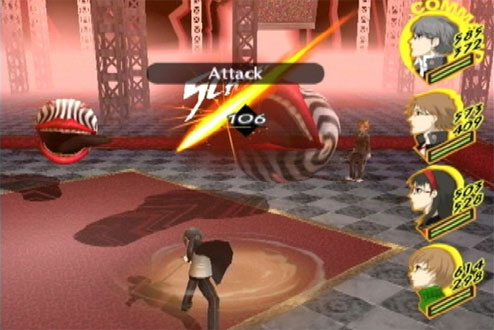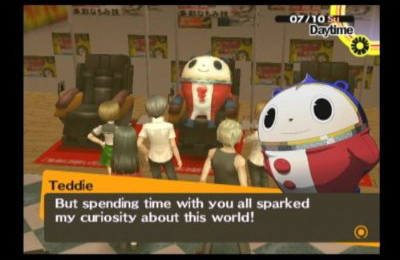
Working from the engine of 2007's Persona 3 (which spent about six years in development), Persona 4 is the latest entry in the Shin Megami Tensei series of role-playing games. Rather than delaying a sequel by developing for a next-gen system, the publishers decided to release a new chapter on PlayStation 2 before the platform was obsolete. This dark role-playing game with Japanese anime styling has a great mixture of style and life that elevates it above the norm.
The male protagonist has just transferred to a new high school. Rumors begin floating around about the Midnight Channel, a program that appears on TV on rainy midnights and will show people their true loves. One stormy night, the curious protagonist checks out the Midnight Channel, which turns the TV into a portal into another world. He does see a woman, but the next morning she's found murdered. The mystery only grows from there, as you and your friends look to find the murderer, and discover why you have gained the power to enter the TV world and summon powerful creatures known as Personas.
Game play is linear early on, as you go to your classes and meet up with your friends afterwards. Once the initial parts of story have been established, you have more freedom to choose what you'll do during the day. You're basically given a high-school student's life to manage. Days of the week matter, as weekends and holidays give you days off from classes, and you have to work on certain nights. Players are rewarded for their choices, whether it's more courage for working in a spooky hospital or improved interpersonal skills hanging out with friends. There are many options but not so many that it gets complicated.
Undoubtedly the real-world aspects will come off as boring to some people, but to a seasoned role-playing-game fan, this is one of the few games in the genre that gets it right. They're called "role-playing games" for a reason, and Persona 4 isn't like other games in which everyday life moves to the back burner because of some catastrophe. The protagonist still has a life outside of the TV world that he has to manage. After all, who would believe a teenager who shirks his responsibilities and claims there's a TV world he has to visit to solve murders?
Once inside the TV world, you begin to develop your power of Persona. Personas are essentially demons that are summoned to do battle for a user. Every other character has a permanently set Persona that directly affects his or her stats (strength, defense, magic strength, etc.), but the protagonist has no set Persona and can harness up to 12 different Personas.
Battles are turn-based events in which you choose to attack (with methods ranging from elemental to physical), use magic, use items, or run away, with the order based on the speed of your Persona. Once per turn, the protagonist can switch Personas mid-battle to exploit enemy weaknesses or avoid his own vulnerabilities, granting him a greater advantage in battle. This might sound unfair, but it's done for a reason: If your teammates fall in battle, you can bring them back with restorative items/magic, but if the protagonist falls in battle, the game is over. It's actually a big difference from most role-playing games, in which even if the main character dies, the game continues until he can be revived by other characters. Here, everything revolves around the protagonist's well-being.
The storytelling is varied, with moments ranging from hilarious (trying to sneak into your female classmate's hotel room but ending up in the teacher's room by accident) to heartwarming (spending time with your little cousin) to traumatic (watching your friends face their own inner demons). There's also an in-depth quality to the storytelling, as you choose specific friends to spend more time with to build "Social Links."
These help with the development of new Personas by granting experience points for a stronger link. Each Social Link with your friends also makes their teamwork improve for team attacks. On top of that, the most powerful Personas can only be accessed by reaching the maximum level of a Social Link. While not required, it's beneficial to maximize Social Links for battles, and the stories behind each character are well crafted and give you a reason to care about your teammates.

Graphically, the game does well with the limited abilities of the PS2, making it look like 3D anime. The in-game character models are passable but blocky and wisely enhanced with closeup 2D images during conversation, along with animated cut scenes for bigger story events. The soundtrack (which is included on a second disc with the game) has a distinct J-Pop sound to it but actually works well with the style of the game, and it's even catchy at times.
The heavy anime styling might turn off some people, and going to classes and work might seem a bit boring, but everything works together in the game, making Persona 4 one of the best role-playing experiences in a while. The combination of managing your life and great storytelling will make sure you stick around for the whole ride.
Persona 4 is available for the PlayStation 2 system for $39.95. For this review, the author completed the story mode with a playtime of more than 70 hours.
Luke Hamilton is a buyer, creative designer, and online coordinator for Video Games Etc. He can be reached at ssj_4luke@hotmail.com.










